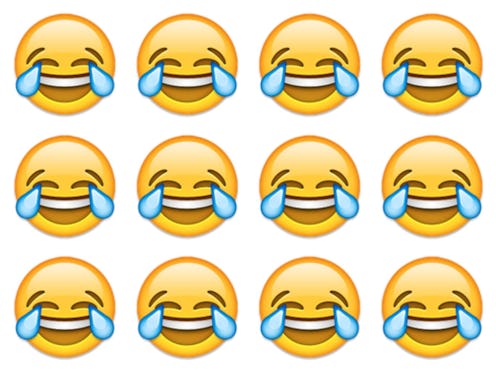
On Monday, Oxford Dictionaries released its Word of the Year... except that this year's "word" isn't actually a word at all. Chosen because it "best reflected the ethos, mood, and preoccupations of 2015," it's the Face With Tears of Joy emoji — which, of course, begets the question: Why do we cry when we're happy? Though many naysayers on the Internet have expressed irritation of the 2015 word of the year, Science of Us points out that we don't actually have a word in English to accurately describe happy tears or tears of joy — which is what likely makes the emoji so popular.
The sentiment of crying while laughing initially comes off as an impossible paradox, but it's no different than wanting to squeeze something because it's so cute, or even the whole "I'll eat you up, I love you so" thing. Researchers call these the seemingly-contraditory emotions — which the Face With Tears of Joy emoji represents so perfectly — "dimorphous expressions." Interestingly, though, we might experience them for different reasons, depending on what body of research you're looking at.
Curious about the science behind the Face With Tears of Joy emoji? I decided to pick up where Science of Us's exploration of the subject left off and see what else I could find about it. Here are three possible, science-based explanations for why we cry when we're not necessarily sad.
1. Happy Crying Is a Signal You're Experiencing Intense Emotion
When people around you see that you're happy-crying, it could signal to them that you need comfort because the emotion you're feeling is clearly overwhelming — and since sadness isn't the only emotion that can be overwhelming... well, you do the math. It functionas as an evolutionary advantage; also, it's the cutest evolutionary trait I've ever heard of.
2. Dimorphous Expressions Help Regulate Our Emotions
According to a paper published in Psychological Science, impulses like wanting to squish something cute or happy-crying could help regulate our overall emotions so that it'll be easy to come down after such an emotional high. Ultimately, though happy-crying might indicate unstable, strong emotions, it's actually happening so you can restabilize later.
3. It Stops Us From Getting Too Happy
Research from Yale suggests that another reason we may experience negative emotion in conjunction with positive emotion — particularly when we see a baby — is to control the emotional stability not in ourselves, but in the baby. Why? Because incredibly positive emotions can actually be more overwhelming than incredibly negative ones. Playful aggression can calm a baby down more successfully than just positive emotion. Go figure.
Images: Emojipedia; Giphy (3)